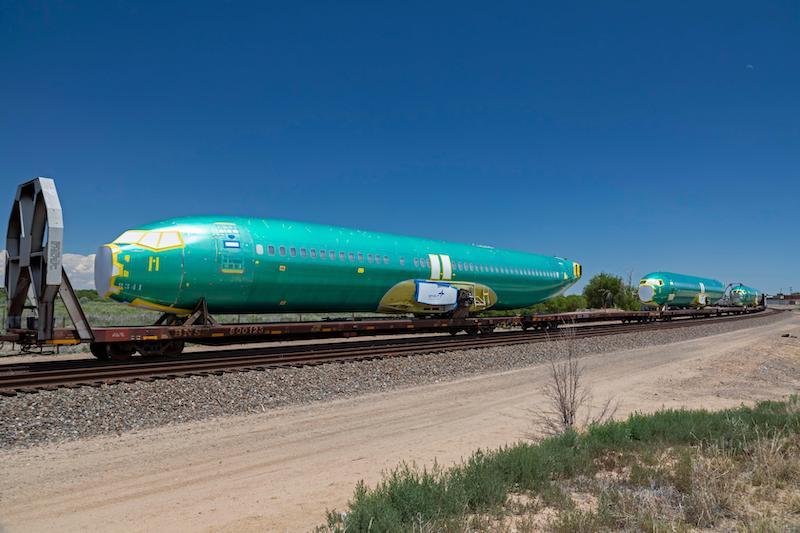
Spirit AeroSystems has completed repair work on vertical fin attachment fittings on all Boeing 737s in Wichita as it simultaneously increases production to meet Boeing’s ramp-up plans to 42 per month.
Commenting on the status of the 737 MAX program during Spirit’s 2023 second quarter earnings call on Aug. 2, President and CEO Tom Gentile says, “all the rework on the available 737 fuselages in Wichita was completed during the second quarter, which was ahead of the timeline we provided on our last call and within the financial estimates that we provided.”
The issue, which concerned non-conformance with two of the eight fittings that connect the vertical tail to the fuselage, disrupted deliveries to Boeing and impacted revenues. Together with a brief work stoppage caused by a strike at Spirit by workers from the International Association of Machinists and Aerospace Workers, the disruption means full-year 737 deliveries to Boeing will be reduced to between 370 and 390 units, the company says.
The negative impacts will be partially offset, however, by Spirit’s accelerating 737 production line. This will be “moving to 42 aircraft per month cycling in August, and we’ll continue at that rate for the rest of this year and then next year; that will be our starting point,” Gentile says. Despite the ramp, he adds “we won’t be able to fully recover the lost manufacturing days from the work stoppage and the subsequent resumption of full production at our Wichita site.”
In real delivery terms, however, the average number of 737 fuselages being shipped to Renton, Washington, will average out at around 35 per month for most of the rest of the year because of planned stoppages for holiday periods and the provision of “blanks” on the production lines to increase surge capacity and provide cushion in the assembly process. However, Gentile says: “We’ve got two full lines, each producing 21 aircraft per month. We will end the year delivering at 42 per month, and that will be the starting point for next year.”
Spirit says the required rework on available units in Wichita was completed within a previously disclosed $31 million cost estimate. However, the company recorded a contra-revenue charge of $23 million in the quarter to account for a potential claim from Boeing related to Spirit’s estimate of the repair work completed to-date on inventory at the Renton facility.
Spirit estimates that Boeing has now completed approximately half of their required rework. In late June, Boeing estimated that 75% of the 225 737s in the undelivered inventory required repair, in addition to several more on the production line. Although the tally does not include the affected in-service fleet, which Gentile previously said could run to around 500 aircraft, Spirit does not expect any material financial impact associated with delivered aircraft already in service. In recognition of the unknown final costs still facing Spirit over the attachment issue, Mark Suchinski, the company’s CFO, says that “any potential claim we may receive from Boeing could be materially different from our estimate.”
Overall deliveries of all products increased to 342 shipsets during the second quarter compared to 318 shipsets in the same period of 2022. This includes 74 737 deliveries compared to 71 shipsets in the same period of the prior year. For other major commercial programs, Spirit expects to round out the year with total deliveries of between 40 to 45 shipsets on the 787, up to 60 Airbus A350 shipsets, 580 shipsets on the A320 and 75 to 80 shipsets on the A220.
Higher deliveries on the 737 and 787, which is now at five shipsets per month, helped increase Spirit AeroSystems revenue in the second quarter to $1.4 billion, up 8% from the same period of 2022. However, the impact of the strike action, higher costs, the 737 tail disruption, and forward losses on 787, A350, and A220 cumulatively led to an operating loss for the second quarter of $120.4 million, compared to an operating loss of $104.7 million in the same period of 2022.
“Over the last 18 months, we have incurred impacts approaching $200 million from individual distressed suppliers and other supply chain pressures, which have been reflected in our past earnings. These challenges in the supply chain also drove some of the forward losses recorded in the second quarter, primarily on the 787, the A350, and the A220 programs,” Gentile says.
For the next few years, Spirit expects that improved production stability across the widebody and A220 lines will improve the outlook, particularly as rates recover at Airbus and Boeing. “Some of the pressure that we saw in 2023 will abate as we move into 2024. There are still loss-making programs. A220 goes up in rate, a nice little tick-up in 2024, which will help,” Suchinski says.
In contrast to the travails on the commercial side, Spirit’s defense and space business had a strong quarter, with top-line growth of 30% over the same quarter last year, increasing revenue by about $45 million. Overall revenue grew to $190 million due to higher development program activity and increased P-8 production.
The company’s aftermarket business also had a robust performance with 15% revenue growth and 26% margins. “Aftermarket growth continues to be supported by the global recovery in air travel and is on track to meet the plan for the year. However, don’t expect it to continue at this level going forward,” Suchinski cautions—adding that the numbers are an uncommon combination caused by the post-pandemic recovery and “the absence of Russian sanction losses.”





